
MAY CONTAIN NUTS

Search Shorpy
SHORPY ART

Framed or unframed, desk size to sofa size, printed by us in Arizona and Alabama since 2007. Explore now.
Join and Share
Ad-Free Shorpy
Shorpy is funded by you. Patreon contributors get an ad-free experience.
Learn more.

Recent comments
- Baldwin 62303
- Baldwin VO-1000
- Cold
- No expense spared
- Tough Guys
- Lost in Toyland
- And without gloves
- If I were a blindfolded time traveler
- Smoke Consumer Also Cooks
- Oh that stove!
- Possibly still there?
- What?!?
- $100 Reward
- Freeze Frame
- Texas Flyer wanted
- Just a Year Too Soon
- WWII -- Replacing men with women at the railroad crossing.
- Yes, Icing
- You kids drive me nuts!
- NOT An Easy Job
- I wonder
- Just add window boxes
- Icing Platform?
- Indiana Harbor Belt abides
- Freezing haze
- Corrections (for those who care)
- C&NW at Nelson
- Fallen Flags
- A dangerous job made worse
- Water Stop
Member Photos
The Shorpy
Print Emporium
Print Emporium
Search Shorpy
Search results -- 30 results per page
- Let's Do Launch: 1943
- May 1943. "Bethlehem-Fairfield Shipyards, Baltimore, Maryland. Portraits of the workers who turn out 'Liberty' ship cargo ... Merchant Navy in the Battle of the Atlantic.
The Baltimore yard built Liberty Ships, eventually 384 of them, along with LSTs ... Posted by Dave - 02/01/2023 - 3:01pm -
![Let's Do Launch: 1943 May 1943. "Bethlehem-Fairfield Shipyards, Baltimore, Maryland. Portraits of the workers who turn out 'Liberty' ship cargo transports, during lunch hour or on rest period." 4x5 inch acetate negative by Arthur Siegel for the Office of War Information. View full size.
Juan de la cruz is awesomeThe photo with "What is being said"? is different from the original "Let's Do Launch". Either Mr. de la Cruz has astounding Photoshop skills or it is the second in a series of pix. Either way it is a personality plus photo.
[I added the photo to show what they were laughing at. - Dave]
Short-lived but crucialThe Birmingham-Fairfield Shipyard existed for less than five years. It was one of two yards (the other in Portland, Oregon) constructed under the 1941 Emergency Shipbuilding Program. The emergency? Even though the U.S. was still officially neutral, it had to react to the severe losses of the British Merchant Navy in the Battle of the Atlantic.
The Baltimore yard built Liberty Ships, eventually 384 of them, along with LSTs (Landing Ship, Tanks) and Victory ships.
What is being saidWould love to know what is causing all the smiles. What is the conversation.
If I had the editing skills, I'd add balloons to each of people with, starting from right to left: "Say what?" "Can't be true!" "He really did that?" "Yup, I saw him -- "
And then I run out of conversation. Someone else, with better imagination, can carry on.
Dave - Thank you for adding it. Wish I could take credit for it, but I can't. It is as fun a photo as the original. Lots of smiles. And I really wish I could hear the comments!
Brown bagsFrom what I can see, they all brown bag their lunch. I wonder why none of them has a black, domed top, metal lunchbox with a handle?
[Because when a metal lunchbox falls on your head from 50 feet up, it hurts. - Dave]
Point taken. The other observation I have is about the guy sitting fourth from the right, including the man sitting on the bottom step. I'm pretty sure he was a football lineman. He's a big guy and he's wearing what appears to be a varsity letter on his sweater.
Waxed paperWhen I was a kid we didn't have plastic sandwich bags. A sandwich wrapped in wax paper worked just fine. At the lunch table, I could lay it flat for a clean place to lay my lunch out on. Occasionally, I'll still wrap a sandwich in wax paper.
The S.S. John W. Brownwas assembled at the Baltimore shipyard in 1942, and is one of two surviving fully operational Liberty Ships preserved in the United States. It is docked in Baltimore, and open for tours and living history cruises.
https://www.ssjohnwbrown.org/
Looks like Central CastingEach one of these guys looks like some character actor. Especially the fellow in the white sweater, I'm sure I've seen him in a Bowery Boys picture.
Good bunch of guysThere's lots of nice body language in this shot. I especially like the fellow, lower center, leaning back into the legs of the guy behind him, who is gesturing with a touch to the shoulder. And, of course, they are of different races -- in a time that racial segregation was widely legal and widely practiced.
VarietyThat's quite a collection of headgear. The man with the bill-less cap probably is wearing it backward, not because it was the style but possibly because he wears a welder's mask when he's working. Today you would probably see uniform OSHA-approved hard hats.
And you wouldn't see any cable-knit sweaters.
(The Gallery, Arthur Siegel, Baltimore, Boats & Bridges, WW2)](https://www.shorpy.com/files/images/SHORPY-8d02521a1.thumbnail.jpg)
- Baby Boy, Baltimore: 1947
- ... top.
Balto and Zepp My big brudda was also born in Baltimore in 1947. Are all of you '47 babies smarty-pants like he is?
And ... Posted by hippo - 07/14/2011 - 7:37am -
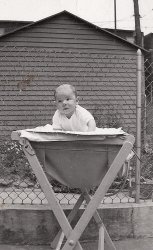
- On the Grid: 1900
- Circa 1900. "Baltimore City Hall." Rising behind a web of wires. 8x10 inch dry plate glass ... years.
http://georgeafrederick.com/index.html
Baltimore must have been very nice then. It's mighty grim now.
Old Balto ... Frederick, City Hall was built in 1875. It escaped the Baltimore Fire in 1904, and was restored in the mid 1970's at a cost of $10.5 ... Posted by Dave - 07/19/2012 - 1:00pm -
![On the Grid: 1900 Circa 1900. "Baltimore City Hall." Rising behind a web of wires. 8x10 inch dry plate glass negative, Detroit Publishing Company. View full size.
PatienceThe guy sitting on the window sill is probably waiting for someone to buy whatever is in the crates that are on the curbside in front of him. If that's not the case, it might be the Mayor on a smoke break.
Not changed much112 years later and it still looks pretty much the same.
This explains the damp pencilIt bears mentioning that George Frederick was all of 21 when he put his pencil to paper and designed this beautiful building, so the expression "wet behind the ears" certainly applies to the young but destined-to-be-successful architect. I have attended a number of meetings there and I wonder what Boy George would think of the metal scanner that greets each visitor nowadays.
His descendants have this Web site that will tell you a lot about Mr. Frederick. I see that his brother, Alphonse, and I attended the same college but a few years apart. OK, many years.
http://georgeafrederick.com/index.html
Baltimore must have been very nice then.It's mighty grim now.
Old BaltoGrowing up in Balto during the 1950s, there were still cobblestone (brick) pavements to be found.
Fruit and vegetable vendors, using horse-drawn carts, traveled throughout the city. They were called "arabbers". It was a thrill for a city kid to see such sights - not to mention the bananas and watermelons.
Sadly, much of old Balto has deteriorated, and the civic pride, evidenced by such a building, is gone.
See: http://en.wikipedia.org/wiki/Arabber
Cat's headsHere in Poland, we call "cat's heads" these type of rock road.
Where the "B'hoys" areDesigned by George Frederick, City Hall was built in 1875. It escaped the Baltimore Fire in 1904, and was restored in the mid 1970's at a cost of $10.5 million. A new Hall would likely have cost about as much, but without any of the class.
Baltimore's political leaders/followers/hangers-on/bootlicks and assorted general characters ["B'hoys"] have done an awful lot of wheeling and dealing inside these walls in that time.
Man on the cornerI imagine he was doing then what I'm doing now, wondering what the heck that watering can is doing at the curb. There is not one flower, shrub, window box or planter in sight in any direction. I don't see any sanitation guys around, and that can is too small for their purposes anyway I would think. Just another of many mysteries these old scenes present to us.
[Possibly associated with the bucket of - what? Tar, perhas? - tterrace]
Well, it may perhave something to do with that paint can with the tip of a brush handle sticking up out of it. It just looks too clean to be related. Both seem lonely and out of place.
Watering canI'd be surprised if that watering can didn't contain something like paint thinner to wipe up drips on the pavement. It doesn't look like he's masking things off.
What Are Those Things?Wondering what those chimney like devices are on the wings; good to see they survived the renovations, but what were they for?
[Chimneys for the steam-heating system is my guess. A large building like this would need a lot of them. - tterrace]
(The Gallery, Baltimore, DPC)](https://www.shorpy.com/files/images/SHORPY_4a17081a.thumbnail.jpg)
- Rolling With the Punches: 1926
- ... E Street NW.
http://www.weschlers.com/
Lord Baltimore's White Arch Anyone have any idea about the arch on the ... fighting apparatus of some sort?
[It's a Lord Baltimore filling station. The thing sticking up is the glass globe atop an ... Posted by Dave - 09/14/2011 - 4:55pm -
![Rolling With the Punches: 1926 1926. "Semmes Motor Co. truck, Walter Brown & Sons." Another from National Photo's series of Washington, D.C., working trucks. This Dodge's battered body notwithstanding, motor trucks were a relative newcomer to a workaday world where dray wagons and horse teams had long dominated. View full size.
Adam Weschler AuctioneerIt's nice to see the truck in front of Weschler's Auction House (warehouse?) now at 909 E Street NW.
http://www.weschlers.com/
Lord Baltimore's White ArchAnyone have any idea about the arch on the right, what's written above it, and what's in the space--fire fighting apparatus of some sort?
[It's a Lord Baltimore filling station. The thing sticking up is the glass globe atop an "American Strate" gas pump. - Dave]
Dave, thanks for answering this. -lesle
Butcher BrownWalter Brown was a butcher at Center Market. The location is the north side of C Street NW, now the National Archives. We see here the rear of buildings which faced on to Pennsylvania Avenue. Adam A. Weschler Auction House was at 920 Pennsylvania Avenue. Lord Baltimore Filling Station No. 1 was at 912 Pennsylvania Avenue.
The Shorpy post, Street View: 1922, shows an aerial of the larger area. The burned-out furniture store at 910-912 Pennsylvania Avenue would become the Lord Baltimore Filling Station.
In contrastit looks like a brand new, shiny 1926 Model T Ford behind the beat up old Dodge.
Weschler FireThis spectacular three alarm fire was reported in the Washington Post 26 March 1915 on page 5. I have a copy of the WaPo article if anyone is interested.
I am so grateful for a photo of this fire damage! My great great grandfather's hotel and saloon, Bessler's Hotel, was next door at 922 Pennsylvania Ave. NW. Bessler's hotel and saloon was also extensively damaged due to the fire and had to be completely evacuated.
The fire may have been linked to a growing dislike of the hyphenated Americans as tensions mounted pre World War I. Bessler's Hotel had a hall where many German-American citizens gathered and on 26 Aug 1914 one of these groups declared themselves loyal to the fatherland (Germany). That must have caused some strong feelings, IMHO.
(The Gallery, Cars, Trucks, Buses, D.C., Natl Photo)](https://www.shorpy.com/files/images/32458u.thumbnail.jpg)
- Porch Life: 1942
- ... housing at the Glenn L. Martin Aircraft Company near Baltimore, Maryland."
https://dbpedia.org/page/Cemesto
Even though ... had been in the sun for awhile. Ouch!
(The Gallery, Baltimore, Dogs, Kids, Marjory Collins) ... Posted by Dave - 09/07/2023 - 1:55pm -
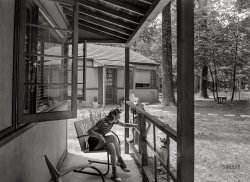
- 1960 Baltimore Family Gathering
- A very strange photo of a family gathering at Uncle George's (in background). I remember this day. View full size.
(ShorpyBlog, Member Gallery) ... Posted by Rick Smith - 12/07/2009 - 1:49pm -
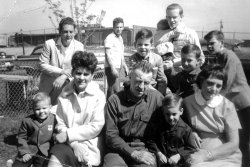
- Capitol Crossing: 1928
- ... this picture was made, struck by a car while crossing the Baltimore-Washington Parkway.
January 1928. "CANINE CHAPERONE. Senator ... Harris & Ewing Collection. View full size.
Baltimore-Washington Parkway? Accounts of Senator Schall's 1935 hit-and-run ... Posted by Dave - 12/28/2021 - 7:11pm -
![Capitol Crossing: 1928 In a tragic twist of fate, Senator Schall -- whose blindness was the result of being shocked by an electric cigar lighter in 1907 -- died seven years after this picture was made, struck by a car while crossing the Baltimore-Washington Parkway.
January 1928. "CANINE CHAPERONE. Senator Thomas D. Schall, blind solon from Minnesota, is now able to get around the Capitol without an attendant since his specially trained German police dog has arrived to lead him around. The dog, 2 years old, has been specially trained for the purpose." 4x5 inch glass negative, Harris & Ewing Collection. View full size.
Baltimore-Washington Parkway?Accounts of Senator Schall's 1935 hit-and-run death say he was struck while crossing the Baltimore-Washington Parkway in Cottage City, Maryland. But the Baltimore-Washington Parkway as we know it was constructed starting in 1947 as a controlled-access road without pedestrians. It does not go through Cottage City.
[At the time it was called the Washington-Baltimore Boulevard (or Highway). - Dave]
It was identical to US 1, no parkway but a notoriously dangerous road.
Two CapitolsThe car is a 1927 Chevrolet Capitol. So the senator is crossing in front of a Capitol in front of the Capitol.
Canine chaperoneThis is one I consider a double embigulator. I generally keep an embiggened Shorpy picture open in a separate tab for a couple of days, and I usually arrive at the scene I want early on. (Before I click it away, I always take another zip around.) The obvious scene here is the blind senator crossing the street, the dog, the car, the license plate, etc., but if you scroll up to fill your screen with only the upper portion of the photo, you are treated to a glorious view of a magnificent dome. Looks almost like a watermark. And it’s blue or even pink. Ethereal.
Not so closeThis is as close as traffic gets to the capitol now. The ornate lampposts with the heavy bases are still there, in the distance.
Electric cigar lighter?I have a hard time believing a cigar lighter could blind him, unless it was fashioned from an old arc lamp street light.
Guiding LightHis dog, who was named "Lux" - not "Fido", as might be inferred from an earlier post - predeceased him (1933).
Blinded by the LighterI searched a bit, but couldn't find any explanation of HOW Senator Schall's blindness was the result of being shocked by an electric cigar lighter! Burns, yes; even electrocution, but blindness?
Baltimore Washington ParkwayThis was probably present-day US 1, or more precisely (since it went through Cottage City) the Bladensburg Road spur now designated route 1 alternate. Most of the Laurel-to-Washington end of route 1 is still designated as Baltimore Avenue or Baltimore Boulevard. The Laurel-to-Baltimore end is designated as Washington Boulevard.
Shorpy image 18093 shows what is now route 1 alternate -- the old Baltimore Boulevard -- at (or just a trifle north of) Cottage City.
Learn something new every day.I had never heard of losing one's sight due to electric shock. First time I have ever heard of that.
Blinded at Cigar Stand"Schall was trying a case in Fargo in 1907 when he used a newly installed electric device at a cigar stand to light a cigar. Connected to the wrong power source, it flashed in his face. Over the next three months he lost his eyesight completely."
From https://www.mnopedia.org/person/schall-thomas-d-1878-1935
Car IDcirca 1927 Chevrolet coupe (pronounced Chevrolay cupay). Note 2 wheel brakes and bald tires! -
Straight plate, bald tiresMade sure his license place was perfectly centered and aligned, but neglected the rubber.
The carSenator Schall is given priority by a 1927 Chevrolet Series AA Capitol sedan
How it happenedSchall was trying a case in Fargo in 1907 when he used a newly installed electric device at a cigar stand to light a cigar. Connected to the wrong power source, it flashed in his face. Over the next three months he lost his eyesight completely. After a period of doubt he resumed his law practice, specializing in personal injury. With his wife, Margaret, doing his reading and writing, Schall prospered; juries liked his oratory.
More on the Cigar AccidentHere is what I found online regarding the accident that robbed Senator Schall of his sight:
"In 1907 he was trying a case in Fargo, North Dakota. Court had recessed for lunch. Thomas and another attorney went to the cigar stand to purchase cigars. The other attorney lit his cigar with a match. But Thomas lit his with a new electric cigar lighter. The lighter exploded and hurled Schall backwards.
His arm was seared, but he still went back into court to finish the day. Thomas noticed that day that his vision was a bit unfocused. As the days progressed, he lost more and more of his sight. Within a year Schall was totally blind."
So my guess is he suffered some kind of head injury, secondary to the "explosion". Maybe he struck something hard when he was hurled backwards and it caused an intracranial hematoma? Just guessing. If that's the case though he's lucky his sight is all he lost.
(The Gallery, Cars, Trucks, Buses, D.C., Dogs, Harris + Ewing)](https://www.shorpy.com/files/images/SHORPY-34686a.thumbnail.jpg)
- Errand of Marcy: 1943
- ... spy at the front of the coach ...
April 1943. "Baltimore, Maryland. Crowded bus carrying people to work at 8 a.m." Photo by ... But these intriguing folks are not riding a streetcar; Baltimore never had the type of PCC streetcar with standee windows as seen in ... Posted by Dave - 08/24/2014 - 2:45pm -
![Errand of Marcy: 1943 The shutter clicked as she fingered the cold steel of the pistol in her purse. "No one suspects," she muttered under her breath, fixing her gaze on the Nazi spy at the front of the coach ...
April 1943. "Baltimore, Maryland. Crowded bus carrying people to work at 8 a.m." Photo by Marjory Collins for the Office of War Information. View full size.
MeanwhileFBI agent "Buck" Knife sat behind her looking for a safe place to stop and confront the Axis of Evil that had infiltrated the bus - as well as the security of America itself - while his partner, Harold "Buffalo" Nichols, grasped firmly on the pole, peering at the woman through his thick lenses waiting for her to make even the slightest move.
Continue the story?Unbeknownst to her, sitting just behind the back door of the bus, over her shoulder, in the fedora, her overseer (and future lover) scanned the sidewalk for the Nazi's contact. The woman sitting beside her wondered if she herself had been that pretty when she was young. And the boy in glasses, staring right at Marjory Collins, now knew -- once and forever -- that he wanted a camera.
Shorpy NoirThe gumshoe watching behind her tried to appear inconspicuous by turning up his collar, but you could tell he was a Fed by the crease in his fedora.
"No one suspects...An old woman", she thought. While her husband waited patiently behind her to hustle her out of the car after the deed was done, his thoughts were more on the National Bohemian he'd have when they got home.
In Vogue?Possibly one of the best fashion shoots of the war years - she's very cool, very stylish.
She's a LookerEnough said.
High CoutureHow many of us ever had a hat made of the same fabric as our coat?
A man could die happyThat woman didn't need a gun, her look could kill. The steely gaze of the true femme fatale.
Noir indeedY'all should get together and write a screenplay. If only we could find a Barbara Stanwyck look-alike to play the lead.
Shorpy got it RightWe are NOT on a bus. This is a "PCC" streetcar, a standardized design created by the "Presidents Conference Committee" just before WWII intended to be universally operable by every streetcar system.
[Actually, the caption should have said "bus." We have amended it to reflect the correction. - Dave]
Not a StreetcarCool photo. But these intriguing folks are not riding a streetcar; Baltimore never had the type of PCC streetcar with standee windows as seen in this photo. It's either a motor bus or electric trolleybus. The original caption says "trolley" which was sometimes used as a term for trolleybus at that time, so there you have it.
Baltimore of the 1940's was a lively place.Looks like a far cry from the grim, depressing city I lived near in the 1990's.
A real femme fatale.No wonder it was in the envelope marked 'killed'. Wonder who her victim was.
See previousShorpy has previously posted several exterior images of these vehicles which were always referred in that time as trackless trolleys. A much quieter version of the look alike Diesel engine bus.
[Actually the caption here should have said "bus." The trackless trolleys don't have the oblong oval window seen here. -Dave]
"Crowded bus"This particular image is uncaptioned in the Library of Congress archive, which was offline when we posted this yesterday, so I had to improvise, being unable to check the adjacent photos for captions. Which would have revealed this shot of the same riders, labeled "Crowded bus carrying people to work at eight a.m." We've amended the caption to reflect this.
Below, at center, a similar coach photographed by Marjory Collins in the Baltimore Transit Co. garage.
Marble StepsOutside the windows a blaze of white rolls by. This was a regular sight on Saturday morning when walking through the side streets on the way to "The Avenue" in Highlandtown.
Noir, With A Web of HorrorI think that older woman is her mother.
And that knowing look on the face of the young woman says she knows you know that is what she will look like in a few years, so she'll have to catch some other prey, sans madre, over margaritas in a darkened corner of a waterfront bar.
It'll be a courthouse wedding and the honeymoon will be over all too soon when the groom meets Mama the first time.
Natty BohTop left of the picture is an ad for National Bohemian Beer, known affectionately by locals as "Natty Boh."
The stranger in the back of the bus.The young man in the back of the bus watched the beautiful spy with intentional vigor. He wondered silently to himself if he could pluck up enough courage to approach her as the exited the transport, even though he was only a teenager, he felt like a man when he was near her.
Whew, now I'm all flustered after writing that
(The Gallery, Baltimore, Cars, Trucks, Buses, Marjory Collins)](https://www.shorpy.com/files/images/SHORPY-8d27951a.thumbnail.jpg)
- S.S. Miami: 1910
- ... the Miami, as Steel Pier, in the spring of 1949 at Baltimore.
(The Gallery, Boats & Bridges, DPC, Florida, Miami) ... Posted by Dave - 09/25/2023 - 5:19pm -
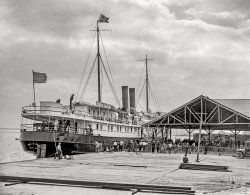
- Grief: 1915
- ... and the representated life from the past.
A Baltimore Legend A copy of this statue became the infamous "Black Aggie" here in Baltimore.
http://www.prairieghosts.com/druidridge.html
Pop Quiz ... Posted by Dave - 09/04/2012 - 9:40pm -
![Grief: 1915 Washington, D.C., circa 1915. "Grief monument, Rock Creek cemetery." Augustus Saint-Gaudens's ambiguously enigmatic bronze memorializing Clover Adams, the society hostess whose suicide led to its commission by her husband, the writer Henry Adams. National Photo Co. Collection glass negative. View full size.
"TMOTHATPOGTPU"Saint-Gaudens's name for the bronze figure is The Mystery of the Hereafter and The Peace of God that Passeth Understanding, but the public commonly called it Grief—an appellation that Henry Adams apparently disliked. In a letter addressed to Homer Saint-Gaudens, on January 24, 1908, Adams instructed him:
"Do not allow the world to tag my figure with a name! Every magazine writer wants to label it as some American patent medicine for popular consumption—Grief, Despair, Pear's Soap, or Macy's Men's Suits Made to Measure. Your father meant it to ask a question, not to give an answer; and the man who answers will be damned to eternity like the men who answered the Sphinx." -- Wikipedia
I remember studying this in college and the ambiguity of the figure sent critics of the time into a tizzy. The lesson ultimately learned was the critics filled in the blanks with their own personal baggage and interpreted the meaning incorrectly.
What's In Your Wallet?Grief.
AwesomeI have lurked in the background for many months, but must break my silence to comment that this is one of best from an incredible collection. It is haunting in many ways, but does speak volumes to the soul of this observer. Thank you Shorpy for all that you bring to the light of those who appreciate the world of photography and the representated life from the past.
A Baltimore LegendA copy of this statue became the infamous "Black Aggie" here in Baltimore.
http://www.prairieghosts.com/druidridge.html
Pop QuizThis monument made it into the history books, I believe I had to memorize a slide with it!
I know this is sad but....it kind of creeps me out!
The Education of Henry AdamsIn his famous autobiography, Henry Adams doesn't mention his wife at all, but he does talk about this statue without identifying its purpose.
BittersweetOh, but this is beautiful -- and the ambiguity works, too -- don't know if it was Henry or Clover of the personification of grief itself.
Roosevelt tieIn her first stay in Washington (when her husband was Assistant Secretary of the Navy), Eleanor Roosevelt would spend hours meditating on this spot. Joseph Lash wrote in "Eleanor and Franklin" that she envied the peace reflected in the tranquil face of the statue.
GriefGood heavens what a stunning work and remarkable bit of photography! I've been gazing at her at every opportunity for a day now, and have more questions about what she says now than I did yesterday. Is she still there?
[Yes. - Dave]
Lived with her (?) for 20 years.My Father was Superintendent of Rock Creek Cemetery and my family lived in a house within the gates. I can't count the times I've looked at this statue and wondered about the meaning of it.
Twelfth Night Shakespeare"A blank, my lord. She never told her love,
But let concealment, like a worm i' the bud,
Feed on her damask cheek: she pined in thought,
And with a green and yellow melancholy
She sat like patience on a monument,
Smiling at grief. Was not this love indeed?"
That's what comes to mind when I see this statue.
Give Me Good DirectionsWhile in Washington for the Inauguration, I drove all over the cemetery looking for this monument, which I first learned of in reading Gore Vidal's Empire. I became a fan of John Hay, which led me to the other eponymous half of the Hay-Adams House, Henry Adams and his dynamos.
I would very much appreciate specific directions once inside the cemetery. Thank you. Jeff Noble
[Click here. - Dave]
We've met.This statue gave me the heeby jeebies when I first saw it. I just happened to be riding through the cemetary. But I knew some great artist created it.
FantasticalBeing a taphophile, I of course love this and want to photograph it myownself. Maybe someday.
Wow, I absolutely love this.And thanks to JennyPennifer for "taphophile." I always knew I was one, just didn't know the name for it.
(The Gallery, D.C., Natl Photo)](https://www.shorpy.com/files/images/31229u.thumbnail.jpg)
- Kennon's Cafe: 1939
- ... readily available or something?
Arrow Beer - Brewed in Baltimore Arrow Beer was brewed by the Globe Brewery on South Hanover Street in Baltimore. The building is long gone now a victim of the Inner Harbor ... Posted by Dave - 04/19/2019 - 4:24pm -
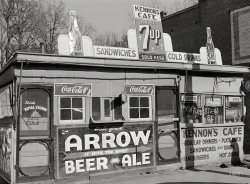
- North From Locust: 1907
- ... Record reviewed three new hotels: the Belvedere in Baltimore, the new Williard in Washington D.C., and the ... Posted by Dave - 08/30/2023 - 6:24pm -
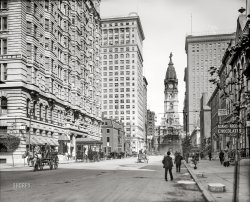
- Hyattsville Hardware: 1940
- ... by Theodor Horydczak. View full size.
5121 Baltimore Avenue Still standing.
[Did they change the name of the ... Posted by Dave - 06/10/2016 - 9:01pm -
![Hyattsville Hardware: 1940 Prince George's County, Maryland, circa 1940. "Electric Institute of Washington, Potomac Electric Power Co. Stores of electric dealers. Hyattsville Hardware." 8x10 inch acetate negative by Theodor Horydczak. View full size.
5121 Baltimore AvenueStill standing.
[Did they change the name of the street? - Dave]
Dave - I'm not sure. I did an initial search using Maryland Ave. as a reference but couldn't find anything. I thought maybe the street was an extension of Maryland Ave. coming out of DC, but it didn't seem to line up (even considering possible street realignments over the years) and that it is actually the extension of Rhode Island Ave. I haven't done a more extensive search if any street name changes have occurred. Using the name of the store, I was able to find the building through a reference to the current business.
Maryland No MoreIn 1925 Maryland Avenue was federally designated as Route 1, but there was also an area-wide street name change in the town in 1941 that eliminated many of the old historic street names.
Built in 1894, the Hyattsville Hardware building originally housed a blacksmith shop and a carriage maker. The Hyattsville Hardware Company opened here in 1914, and it has had several owners including Neuman Dudrow, the Norman brothers, and the Risden family. The store closed in 1990. The Franklin General Store opened in its place in 1992.
Now a great restaurant and craft beer venueFranklin's Restaurant on Route One is a popular meeting place for Hyattsville residents. In the taller of the buildings shown is a store with unusual toys, games, candies, wines, and cooking utensils.
My Sears kit house was delivered in two railroad cars to the Hyattsville Hardware store, which sits next to the train tracks, in 1926, and delivered to the building site by a horse-drawn wagon.
The funky vibe of Franklin's has influenced the Arts District improvement plan for the mile or so north of it on Route One. The many old auto repair stores and dealers there were replaced by attractive row homes and small businesses.
Westinghouse AutomealThe electric roaster in the window caught my eye. My 90+ years old aunt has one like that and uses it regularly.
If they don't got itYou don't need it. I wish I could shop in that store. I see lots of things I'd love to have.
From "Best Paint Made" to "Best Paint Sold" ?But originally from Burtis, Patterson, Sargent Co..
(The Gallery, D.C., Stores & Markets, Theodor Horydczak)](https://www.shorpy.com/files/images/SHORPY-5a44931u.thumbnail.jpg)
- Hyattsville: 1940
- ... I think).
The next two tracks to the left are the Baltimore & Ohio Washington Branch, opened in the 1830s. Note the fence ... the depot and turned south, connecting with a track from Baltimore to lead to the Alexandria Branch to Virginia. That branch today is a ... Posted by Dave - 03/26/2019 - 7:34pm -
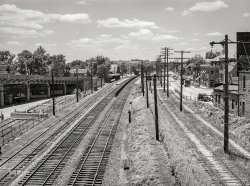
- Photo Finish: 1924
- ... to right (deduced from articles in Washington Post and Baltimore Sun):
unknown (in back), L. Bressler (third, Washington), Mabem and Baker (tied for 4th, Baltimore), Joe Tarshes (first place, Washington), Harry Mason (second place, ... Posted by Dave - 04/24/2015 - 9:59am -
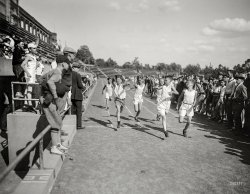
- Class Photo: 1905
- ... that burned in New York in 1911.
Now approaching Baltimore ... If this group ever got caught in a headwind, the boys would be ... Posted by Dave - 09/13/2022 - 2:39pm -
![Class Photo: 1905 Washington, D.C., circa 1905. "Business High." Harris & Ewing glass negative. View full size.
StrayerWas this related to Strayer Business College later?
[Strayer Business College got its start in 1892. Business High, a public school, opened in 1904. In the 1930s it became Cardozo High School. - Dave]
ImpressedTwo of the girls stand out, in the front row, the second girl from the left for her beauty and the second girl from the right for her classic look.
Can Do - Will doIt's rare to see so many determined expressions. Each one is beautiful in his or her own way just because of the "I can and will" expressions on their faces and, most important, in their eyes. Never mind that some are prettier or handsomer than others. They'll make it.
LocketedIt is interesting how many of these young women are wearing lockets, the woman second row, third from the left, possibly a locket watch ?
How intriguing to wear a hidden secret as jewelry.
Beautiful blousesI am in awe at the detail in these ladies' blouses. The lace, the smocking, the pleats, the eyelet.... Do you think these were made by the girls or their relatives or would this be an item they could just pick up at a store?
No letting your hair downUntil the mid-1960s, once a girl reached puberty her long hair had to be worn up at all times, except at bedtime. No respectable woman could appear in public with her hair down unless she was fleeing an earthquake or a house fire. Even after women began cutting their hair short, those who kept long hair were expected to wear it up until the 1940s at least, and even those who wore it down like Veronica Lake usually cut it to shoulder length. Truly long hair worn down was not socially permissible in most parts of the country until the end of the 1960s. When a girl I knew in high school in San Diego in 1966 started wearing her waist-length hair down, her not-very conservative parents threatened to throw her out of the house for "getting wild."
I can't help but notice ...that all the women have long hair worn up. Was that the style of the day, or was it de rigueur for graduation pictures?
Math LessonsI can just hear the math classes "Naught from naught is naught..."
My parents (born 1917 and 1919) used "naught" for zero for many years.
We need this type of HS again, I see too many young people entering the work force with a college degree but lacking in basic skills, particularly technical writing.
Familiar FacesI see in these faces other people I have known, although none of them are these kids, perhaps their descendants. Some of these girls, given a few more years, will become head-turners, especially after the Gibson Girl look is past. Some of the boys will be lady-killers. I love the crisp but subtle modeling that these glass negatives give, kind of like an Old Master in grayscale.
Beautiful WaistsAt the time of the photo, the elaborate cotton blouses worn by these girls were usually called waists, or shirtwaists, and equally complicated examples could be made at home or purchased in stores. Experienced seamstresses could purchase an astonishing variety of inexpensive machine-made lace and cam-embroidered trims, edgings and insertions from notions stores, department stores and fancy-goods shops, or get them from mail-order catalogs. The shop window in the photo of Apolonia Stuntz's "Fancy Store" displays lace edgings, flounces and trims that are similar to those on some of the shirtwaists seen here. Ready-to-wear shirtwaists from department stores and shops were mostly produced in sweatshop garment factories, such as the notorious Triangle Waist Company factory that burned in New York in 1911.
Now approaching Baltimore ...If this group ever got caught in a headwind, the boys would be airborne in a second.
Before flappers bobbed their hairUntil the 1920's when flappers shockingly bobbed (cut) their hair, all women let it grow and pinned it up. My grandmother (who would have been a contemporary of these girls) had hair to her knees and combed it out each morning, then pinned it up. The 5 or so inches closest to the floor weren't even gray because they had grown so long ago. Only prostitutes supposedly wore their hair down. So a woman of fine reputation always wore it up.
You ought to know that....Too funny about the naught.... My mother used to say "ought" without the N. She was also born in 1919, in Manitoba, of Icelandic descent. Perhaps that is how they pronounced it up here then? I had forgotten all about the ought thingy and darn near laughed myself off my chair when I read your comment. Good wit.
[Says Webster: "Aught" is an alternate spelling of "naught" that from an incorrect division of "a naught" as "an aught." - Dave]
(The Gallery, D.C., Education, Schools, Harris + Ewing, Portraits)](https://www.shorpy.com/files/images/14941a.thumbnail.jpg)
- Washington, D.C.: 1904
- ... Detroit Publishing Company. View full size.
Baltimore Sun Bldg Also visible, the Baltimore Sun Building (aka The American National Bank) with The Cairo behind ... Posted by Dave - 08/30/2012 - 10:46am -
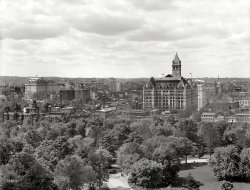
- Arcade Hockey Club: 1926
- ... Post, Jan 18, 1926
D.C. Hockey Team Defeats Baltimore
A new dish was served on Washington's sports menu last night at the Arcade when teams representing Washington and Baltimore met at roller hockey. The Capital Cityans winning, 3 to 1.
The ... Posted by Dave - 08/18/2012 - 5:44pm -
![Arcade Hockey Club: 1926 January 22, 1926. Washington, D.C. "Arcade Hockey Club." And if roller hockey isn't your cup of tea, we also have Billiards Dancing Bowling. View full size.
Hard CoreThey look like some pretty tough hombres.
Street hockey ancestorsLet's see: cricket pads, field hockey sticks, a tiny net, and a softball.
Turn those roller skates into rollerblades, and you've got a typical makeshift street hockey game in my neighborhood in the 1990s.
Capital Cityans
Washington Post, Jan 18, 1926
D.C. Hockey Team Defeats Baltimore
A new dish was served on Washington's sports menu last night at the Arcade when teams representing Washington and Baltimore met at roller hockey. The Capital Cityans winning, 3 to 1.
The game is both fast and rough but seemed to appeal to the gathering on hand, made up mostly of skaters. The visitors scored their lone tally shortly after the opening whistle blew when Freeman, running down the sidelines, scored on a chance shot. Before the first period ended Washington tied the score, and its two other goals came in the second. The third was a scoreless one for both teams.
Houston easily starred for Baltimore, while the Whitings were the locals best bets.
The listed Washington players are: Barkley, Morrow, Harrison, W. Whiting, H. (Harry) Whiting, and Ferguson. A roller hockey match consisted of three 15-minute periods.
LocationI wonder if this was taken at the Uline Arena which was located where the Watergate complex is now. Any guesses?
[The Arcade roller hockey club played in the Arcade Building at 14th Street and Park Road. Uline arena (which was nowhere near where the Watergate is) was built in 1940, for ice hockey. - Dave]
(The Gallery, D.C., Natl Photo, Sports)](https://www.shorpy.com/files/images/27423u.thumbnail.jpg)
- Charm City: 1943
- April 1943. "Baltimore, Maryland. Elevated trolley." A restaurant, gas station, public ... found here .
House of Welsh According to a Baltimore Sun article dated January 23, 1998, "The House of Welsh -- the aged ... out of the way to convert the car to an open car for Baltimore's hideous summers. The semi-convertibles saw service on all the ... Posted by Dave - 06/05/2013 - 2:03pm -
![Charm City: 1943 April 1943. "Baltimore, Maryland. Elevated trolley." A restaurant, gas station, public transportation and booze all in one handy view. Photo by Marjory Collins for the Office of War Information. View full size.
Re: Extra RailThe extra rails are an attempt to keep derailed equipment from traveling into critical structures such as bridge truss supports, or falling off decks as shown. Depending on the track gauge, derailed equipment could travel four to five feet sideways before the wheels contacted another rail, enough to be a bigger problem than simply hitting the ground. They are curved at the beginning to guide derailed wheels back into a near correct path prior to critical structures, perhaps cheaper than using longer rail material and starting the extra rail sooner.
Extra railsYour question is a good one. Those extra rails you see running parallel to the running rails was/still is a safety feature. When a train's wheel derail for whatever reason, the wheels fall into that slot thats created by the inner rail. It will prevent, in most cases, the train from going further sideways. On a trestle, you can see the advantages.
Expensive premium gasThe gas prices shown are presumably for regular and premium. Note that the price for premium is 50% higher than the price for regular. If that were the case today, premium would be somewhere around $1.75 a gallon higher than regular. But difference typically actually seems to be 30 to 50 cents.
H. Kohnstamm & Co.A bit of history, found here.
House of WelshAccording to a Baltimore Sun article dated January 23, 1998, "The House of Welsh -- the aged downtown restaurant-bar where political deals were cut between slices of sizzling steak and shots of Maryland rye -- is closing next week."
The article went on to say that they didn't get many calls for rye whiskey anymore. Too bad they couldn't have held on a few more years. Rye has made a huge comeback recently. I wonder how "Welsh's Black Bottle" would stack up against some of today's ryes, like Bulleit or Knob Creek.
Guilford Avenue at Saratoga StreetView Larger Map
Gas 5 gal/$I remember my father complaining at the gas station when it went to .239
Guard railsD A N- The extra set of rails on bridges and elevated sections of track are guard rails. If a train were to derail on one of these structures, the wheels would theoretically be kept between the rail and the guard rail, and keep it on the structure. They are curved or tapered (or commonly, actually joined at the centerline) at each end in case the engine(s) or car(s) are already "on the ground" when approaching the danger area.
Extra RailsCan someone explain the extra set of rails that often show up between the regular rails on bridges. In this photograph they're quite clear on the right "lane". Why are they always curved at their start point?
Guardrails.They are called guardrails. Their purpose is to prevent a derailed piece of equipment from leaving the ties and falling off of an elevated structure. They are tapered at the beginning to pull an errant piece of equipment back on the ties prior to going onto an elevated structure or bridge. Also, they are called tracks, not lanes.
The classic semi-convertibleThe car in the photo, no.5575 was one of a group built in 1914 by Brill in series 5560-5644 for United Railways & Electric. Between 1905 and 1919, United bought 885 semi-convertibles, all of them built by Brill or its subsidiaries Stephenson or Kuhlman. United also inherited a number of semi's from its predecessors.
The cars were called semi-convertibles because the window sashes could be raised out of the way to convert the car to an open car for Baltimore's hideous summers. The semi-convertibles saw service on all the Baltimore lines and some were still on Baltimore Transit's roster at the end of service in 1963.
The elevated structure was only about two thirds of a mile long and double tracked. It was built to cross over a stretch of Guilford Ave. that was already occupied by freight tracks of the Northern Central Ry. [PRR] The last car passed over Baltimore's elevated on Jan. 1, 1950.
Girder railWith all this talk of rail, no one mentioned the girder rail in the photo. I was initially surprised to see this here in 1943. While used forever across the pond, didn't think it was used widely here in the US at the time.
+71Below is the same view from July of 2014.
(The Gallery, Baltimore, Gas Stations, Marjory Collins, Streetcars)](https://www.shorpy.com/files/images/SHORPY_8d27948a.thumbnail.jpg)
- Trunk Line: 1938
- ... the Farm Security Administration. View full size.
Baltimore & Ohio? That actually looks like a B&O-style color ... Posted by Dave - 10/30/2017 - 11:11am -
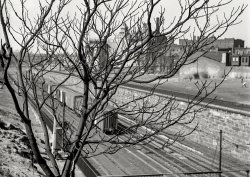
- Maryland Packers: 1909
- ... of them there are. Also probably because I have family in Baltimore, and can imagine a grandparent or grand-aunt or uncle in their midst. ... I points it here, and then I points it there...
The Baltimore Biloxi Connection.. Before the migrant crop workers, there were ... Posted by Dave - 04/16/2009 - 10:40pm -
![Maryland Packers: 1909 July 1909. "Some of the workers in a Maryland packing company." Photograph by Lewis Wickes Hine. View full size.
Second grade class photoThis would be appropriate for an elementary school class picture. Hardly anyone seems to be older than nine. I am glad that things have changed for the better.
There's a ringer in the photoAw, c'mon. You can't tell me the baby in brother's arms on the left does any work at this factory.
Day careYes, many of these children are very young but Mama had two choices since she needed to work: bring them with her or leave them home alone. I am neither condoning nor accusing but facing the reality of the times.
Thank God for child laborThank God for child labor laws. It's ridiculous when the sweet-faced girl with her hair up on the right looks like everyone's mom or teacher, and she's probably only twelve or thirteen...
Future planningInteresting how most of the girls' dresses either have tucks or large hems to allow for growth. Also interesting is that the baby has shoes, even though (s)he may not be walking yet, while most of the children in front do not. Guess they were left over from older sibs and might as well be used.
What did they use the baby forA doorstop? A paperweight? Thank God for child labor laws. No child should have the eyes of an old, disillusioned adult!!
What were they packing?Normally I can look at Hine's photos and see distinct points of view. Life was different back then, and children worked to support their families or themselves. But this photo is haunting because of just how young the subjects are, and how many of them there are. Also probably because I have family in Baltimore, and can imagine a grandparent or grand-aunt or uncle in their midst. A potential personal connection always hits harder.
Bean plant revisited?Was this photo was taken on the same day, at the same factory as the Bean Stringers that was posted on April 14? Notice the girl in the striped dress who has shoes, fourth from the right, in the first row. She seems to be the same little girl in the front right of that photo. Same striped dress, only she has an apron over it in this shot. And the little boy holding up the pail, could he be the same kid half hiding behind the post in that photo? What a rascal he must've been.
[It could be. The original caption information for this image is missing. - Dave]
Science fictionYou couldn't get any kids that age to do any work these days, so I figure that lady in the very back, the one laughing, she must have been the one that carried the whip.
The Golf links lie so near the mill...I am reminded of Sarah Norcliffe Cleghorn's short but powerful poem:
The golf links lie so near the mill
that almost every day,
The laboring children can look out
and see the men at play.
When I taught english literature to grade nine students, this was always my first lesson, after which we would take turns looking out the classroom window and commenting on how the world looked from the inside. (Then I'd make them get to work. The irony was not lost on them.... heh heh)
Ansel Adams had the Zone System... I'm working on the points system. First I points it here, and then I points it there...
The Baltimore Biloxi Connection..Before the migrant crop workers, there were European immigrants who followed work all along the Eastern seacoast in the early 1900s. Several families from the Seafood factories in Baltimore eventually settled in Biloxi, Mississippi - working for the dozen or so factories in what was then "the seafood capital of America". Most were Slovian - from Yugoslavia and Czechoslovakia - their once strong presence on Biloxi’s Point Cadet is still marked by the names of streets, businesses, and the Slovonian Society Social Club.
Seeing this picture reminds me of the stories my mother told, and particularly about my Aunt Beulah working as a child in the factory.
The factories lined Biloxi’s Back Bay where the schooners docked to unload their catches. Workers lived near the factor. Some were fortunate to find low cost housing in factory owned “camps” – Dirt floor shacks often housing multiple families – with a community privy out back. Each factory had its own distinctive whistle - blown before the crack of dawn to summon its workers to “come to work”. Beulah was about 9 years old - the oldest of 5 children. Being as her father was (in her words) “…a useless, good for nothing, wife-abusing drunk…” Beulah and her mother worked the factories making just enough to keep the family fed.
Beulah worked on the shucking floor. Each worker had a place at a bench – that was actually part of a shelf along the wall. The room was built on a pier with openings in the floor to let the seafood juices and trash fall into the bay below. In the cold winter months the chilly winds blew up through the cracks in the floor making an already miserable job tortuous.
Steel tracks on the floor led to the steaming area. Every so often a huge basket-like trolley rolled into the room brimming with steamed open oysters. The young workers collected them using sacks or their aprons, and carried them to their work bench. Then the long process of prying open the shells, saving the meat in the can, and throwing the shells out of the wide open windows onto the pile outside.
When the cups were full - sometime it could take an hour or more, depending on the size of the oysters and how well steamed they were - the worker took their cup to the much despised "checker". The checker - usually an older woman – who job was to make sure the cup was full of oysters as possible and very little liquid. If she felt there was too much liquid, she would press and drain the contents, and hand the cup back to the worker to "finish filling it".
The hours were long. The conditions were poor and unsanitary with the oyster juice running down bare arms and legs. But it paid - FIVE CENTS A CUP !!
So when I see pictures like this one, I can't help but wonder: "Why are some of these children smiling?"
People say we're going through hard times today. But pictures like this one tell a story of much darker and harder times. We have much to be thankful for.
Relativity>> I can't help but wonder: "Why are some of these children smiling?
Maybe they're smiling because they have jobs and will eat supper tonight!
It is through the prism of modern day society that we are appalled by the notion of child workers; but over the long history of man this has been normal. The way that we raise our children now is abnormal when compared against the history of mankind. (I'm not suggesting it was better back then ... just that this was normal.)
America was, for much of the 18th and 19th centuries, an agrarian nation - and our workforce consisted of the children our women bore. They were put to work as soon as they could lift a grain bucket to feed the chickens.
What's striking to me about the photo is how healthy these children look compared to the obesity so common in our children today.
(The Gallery, Kids, Lewis Hine)](https://www.shorpy.com/files/images/00750u.thumbnail.jpg)
- Hop Till You Drop: 1923
- ... lasted well into the 1930s; woman on the right holds a Baltimore newspaper clipping with the headline DANCERS BREAK WORLD RECORD AND ... dancers will in a similar manner take themselves to Baltimore to finish their efforts to gain a world title.
The ... Posted by Dave - 08/13/2013 - 4:25pm -
![Hop Till You Drop: 1923 April 1923. Washington, D.C., or vicinity. "Marathon dancers." Participants in a pop culture fad that lasted well into the 1930s; woman on the right holds a Baltimore newspaper clipping with the headline DANCERS BREAK WORLD RECORD AND DISAPPEAR. Harris & Ewing glass negative. View full size.
Victor Victrola VV-100The phonograph is a Victor Victrola VV-100, produced from 1921 to 1925. Original price $150. One sitting behind me in my library right now.
Low-down on the Victrola VV-100http://www.victor-victrola.com/100.htm
Manual includedThis link has a page by page instruction manual for that Victrola.
I have one of those victrolas......and it still works. Looks like they have the volume turned all the way up
Oh, how we dancedThis sorry looking group of incongruous personalities reminds me of the 1950's rhyme sung to the tune of the Anniversary Waltz:
"Oh, how we danced on the night we were wed,
if you think we danced, you have rocks in your head."
(second verse)
"Oh, how we danced on the night we were wed,
we danced and we danced 'cause the room had no bed."
(I know it is like eighth grade boys' locker room humor, but it all comes back even sixty-plus years later.)
Yowzah, yowzah!I guess all the other horses have already been shot.
Comfy ShoesNotice they all have them to make this grueling task as painless as possible. Wonder why the young lady seated seems so surprised by the photographer?
Movable Marathon
Washington Post, April 21, 1923.
As the third lap of Washington's marathon dancing contest got under way last night, eliminations had narrowed the field to three at the Arcade auditorium and four a the Central coliseum.
Upon completion of a 48-hour stretch of continuous dancing, Miss Florence Gentry, the last girl competitor at the Arcade, became hysterical, and was carried sobbing and shrieking from the floor. The remaining entries were Aubrey W. Gilbert, 22-year-old marine from the local marine barracks; Joe Boltrotsky and W.C. Mendenhall, of Mount Rainer, Md.
At the Coliseum Elsie Weber held the honor of being the only contestant still dancing in the two contests. Her male competitors there were Edward Fleury, Louis J. Hulleran and Walter Keefer.
The Arcade dancers who are still dancing at midnight will continue their gliding at that hour in a moving van, which will convey them to a dance hall in Virginia. The Coliseum dancers will in a similar manner take themselves to Baltimore to finish their efforts to gain a world title.
The Baltimore Sun, April 22, 1923.
Only three of the five marathon dancers who started out Wednesday night to set a new recod were left at 1 o'clock this morning. One of them is Miss Elsie Weber, of Baltimore, who recently danced 53 hours in that city. Just before midnight the dancers, who were staging there contests in two halls one-stepped into phonograph equipped trucks and [departed] for Virginia or Maryland so as to evade the District of Columbia Law.
… In the meanwhile Miss Weber, the other two contestants and William T. Farrell, of Baltimore, an added starter, had crossed the district line into Maryland. They went to Beckett's Hotel at Marlboro and were going strong at 1.30 this morning.
The Baltimore Sun, April 23, 1923.
All records for endurance dancing were shattered last night by Miss Elsie Weber, of Baltimore and Eugene Linder, of Washington, who dashed from the floor of Ducket's Hotel, at Marlboro, Md., five minutes before midnight after they had danced for exactly 96 hours.
Miss Weber and Linder, in company of William T. Farrell, of Baltimore, who had completed 71 hours of continuous dancing, jumped in a waiting automobile and disappeared. It was thought that they were going to Washington to continue the contest. Police and newspaper men watched various dance halls in Washington for the arrival of the dancers, but at an early hour this morning they had not been found.
Washington Post, April 23, 1923.
Three contestants for the world's record for marathon dancing passed the ninety-six hour of continuous dancing last night at 12 o'clock at Duckett's hotel in Marlboro, Md., where they were taken from the Coliseum at midnight Saturday because of police regulations prohibiting public dancing here Sunday. The three dancers who were reported to be still going strong are Mrs. Elsie Weber and Eugene Linder, both of this city, and William P. Farrell, of Baltimore.
The Baltimore Sun April 24, 1923.
Eleven competitors in the Marathon dance contest at Hazazer's Hall completed their first day of continuous dancing last night in their efforts to win the title of world's champion endurance dancer. …
Claiming to have danced 109 hours, Miss Elsie Weber and William Farrell, of Baltimore, were stopped by the police at the Pen Gardens, in Washington. Police declared the management of the Pen Gardens did not have a permit to conduct the contest.
Spectators who went to Ducket's Hotel, at Marlboro, where the dancers fled on Sunday from Washington to dodge the police, according to dispatches to THE SUN, declared they were disappointed at the long rests given the dancers.
Miss Weber last night denied reports published in Washington that stretches of several hours had been spent in sleeping since the contest started.
The Baltimore Sun April 27, 1923.
Up at Hazazer's Hall it is difficult to tell whether they are holding a non-stop dancing contest or a non-stop sleeping handicap. Yesterday the hall was closed from 2 P.M. until 11 P.M. No spectator was admitted.
Dating In The ThirtiesMy parents used to go to the Dixie Ballroom at Gwynn Oak Park in Baltimore to watch these dancers in the 30's on a date. Years later my mother would shiver with disgust at the tortured looks on the dancer's faces when she would tell us about them.
To top off the date my mom and dad would go to speakeasies in the Remington area for some illegal beer and tell my grandmother (mom's mother) they had gone to an ice cream parlor and took a walk home the long way.
I always smile when I think back about the tales my parents told me they did as young people. Yep mom was a proud flapper with bobbed hair and dad made beer in his parent's basement.
(The Gallery, D.C., Harris + Ewing)](https://www.shorpy.com/files/images/SHORPY_42979a.thumbnail.jpg)
- Pool Parity: 1954
- ...
1954 Fort Ord, 1955 Camp Zama Japan, 1956 suburban Baltimore, 1957 settling in SF bay Area. When people ask where I'm from I say, ... Posted by Dave - 05/31/2023 - 5:05pm -
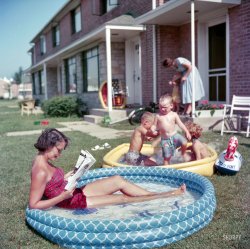
- Team Players: 1906
- ... May 4, St. John's College, May 5, Country School of Baltimore; May 8, Georgetown Preps; May 11, Eastern High; May 12, Country School, at Baltimore; Ma 15, Episcopal High School, at Alexandria; May 18, St. John's ... Posted by Dave - 08/07/2012 - 3:34am -
![Team Players: 1906 Washington, D.C., or vicinity, 1906. "Boys school baseball '06." Harris & Ewing Collection glass negative, Library of Congress. View full size.
School for BoysI wonder if this school became Wilson High School later. That's close to Tenley Circle and that area of Wisconsin Avenue. Photos like this always lead on to new info about an area.
[There were several Washington-area schools that went by the name -- one was the Washington School for Boys on Wisconsin Avenue (the photo above), a boarding school whose property was sold off over the years and incorporated into both the Sidwell Friends School and National Cathedral School for Boys; in Alexandria, "Washington school for boys" (or just Washington School) was the unofficial name for the George Washington School, an all-male public school whose student body was combined in 1923 with the Lee School for Girls to form the Jefferson School. There was also a day-school program called Washington School for Boys (a.k.a. Vacation School for Boys) at the YMCA's G Street complex, begun in 1906 as a remedial summer school. - Dave]
Muggers beware!Is there any doubt that any one of these guys would be serious trouble for today's gangstas and muggers? Whatever happened to the America seen on Shorpy??
Pre-RalphitesAnother batch of those wonderful R. Lauren sweaters! Everything old is new again, indeed. Any idea from whence the W.S. comes from?
Washington School for BoysThis photo appeared on June 10, 1906, Washington Post; labeled "Baseball Team, Washington School for Boys."
Boys School Schedule
Encouraged by the success of its relay team during the indoor season, the Washington School for Boys is now developing its baseball team, which promises to be the strongest that has ever represented the Wisconsin avenue institution.
Several preliminary games have already been played, but the regular season on the diamond will start to-morrow, when the team meets the Episcopal High School, of Alexandria. The other games on the schedule, which has just been completed by Director of Athletics Bryant, follow: April 24, Western High; April 27, Friends Select; May 4, St. John's College, May 5, Country School of Baltimore; May 8, Georgetown Preps; May 11, Eastern High; May 12, Country School, at Baltimore; Ma 15, Episcopal High School, at Alexandria; May 18, St. John's College; May 22, University School of Baltimore.
Washington Post, Apr 19, 1906
Baltimore Boys Defeated
Washington School Ball Team Grabs Victory in Last Inning.
The baseball team of Washington School for Boys jumped into the club representing the Country School of Baltimore in the seventh, eighth and ninth innings yesterday afternoon and grabbed victory from defeat. The game was played on the Washington School grounds, Tennallytown road. Score, 11 to 10.
In the first stages of the game it looked as if the boys from the Monumental city would have an easy time, and until the last inning it was all their way, but the local boys took a brace and landed on Goodwin's delivery, lacing the ball to all corners of the lot.
In the first part of the game the Washington boys lacked the enthusiasm, and until this was supplied by a large crowd of rooters, who gathered to the witness the game, it was played in a listless manner.
...
Bard, c. rf
White, lf, c
Britton, ss
Macartney, 2b
Pilson, 1b
Bliss, 3b
Hemingway, cf
Johnson, lf, rf
Woodward, p.
Washington Post, May 13, 1906
RE: Muggers Beware!I'm not so sure about the fellow with the cap standing there, but otherwise, point well taken. That America expired, to be eventually replaced by this America.
WSBWSB, a private boarding school, was located at Wisconsin Ave and Garfield St. had ZERO connection with Wilson (not even a thought in 1906) or Western (one of 5 DC public high schools).
(The Gallery, D.C., Harris + Ewing, Portraits, Sports)](https://www.shorpy.com/files/images/14634a.thumbnail.jpg)
- And bless Leo Durocher ...
- ...
Age She's the same age as my mom, who was living in Baltimore at this time. My grandfather built Liberty ships. Echoes through ... Posted by Dave - 06/20/2023 - 4:44pm -
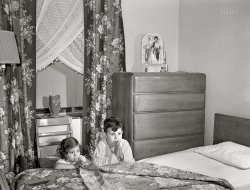
- At Ease, Soldier: 1942
- March 1942. "Baltimore, Maryland. Sergeant Franklin Williams, home on leave from Army duty, ... lives!.
1915-1975 Franklin's obituary in the Baltimore Sun of May 2, 1975.
Sergeant Franklin Williams ... in Missouri. - Dave]
(The Gallery, Arthur Rothstein, Baltimore, Eateries & Bars, Pretty Girls, WW2) ... Posted by Dave - 03/19/2023 - 8:10pm -
![At Ease, Soldier: 1942 March 1942. "Baltimore, Maryland. Sergeant Franklin Williams, home on leave from Army duty, with his best girl Ellen Hardin, splitting a soda. They met at Frederick Douglass High School." Photo by Arthur Rothstein for the Office of War Information. View full size.
What a wonderful photoTwo happy people. I hope they lived long, happy and healthy lives!.
1915-1975Franklin's obituary in the Baltimore Sun of May 2, 1975.
Sergeant Franklin WilliamsHere's his draft card.
Best WishesI see that he is a Combat Engineer in the First Army. He will more than likely go to Europe with the First Army.
[He left Fort Bragg for officer candidate school at Fort Belvoir, where he became 2nd Lieut. Franklin Williams. He was then assigned to Fort Leonard Wood in Missouri. - Dave]
(The Gallery, Arthur Rothstein, Baltimore, Eateries & Bars, Pretty Girls, WW2)](https://www.shorpy.com/files/images/SHORPY-8d03329a.thumbnail.jpg)
- Chicken Dinner: 1942
- March 1942. "Baltimore, Maryland. Sergeant Franklin Williams, home on leave from Army duty ... range made by the Standard Gas Equipment Corporation of Baltimore. Medium format acetate negative by Arthur Rothstein for the Office of ... oven is turned off.
(The Gallery, Arthur Rothstein, Baltimore, Kitchens etc., WW2) ... Posted by Dave - 03/19/2023 - 12:56pm -
![Chicken Dinner: 1942 March 1942. "Baltimore, Maryland. Sergeant Franklin Williams, home on leave from Army duty at Fort Bragg, watching his mother put chicken into the oven." Specifically, an Oriole range made by the Standard Gas Equipment Corporation of Baltimore. Medium format acetate negative by Arthur Rothstein for the Office of War Information. View full size.
BittersweetI find these two most recent Shorpy pictures of Sergeant Williams to be bittersweet: the joy of being home with family combined with the poignant knowledge that he would soon be shipping out. None of the three articles state what happened to Sergeant Williams over the course of the war. I hope he made it back home okay.
[Odds are he didn't ship out anywhere. Only around one in ten of the 1.2 million African-Americans in the military during WW2 served overseas. You can read more about Franklin here. - Dave]
Could take quite a while... for Mom to get that chicken the way Franklin likes it, since the oven is turned off.
(The Gallery, Arthur Rothstein, Baltimore, Kitchens etc., WW2)](https://www.shorpy.com/files/images/SHORPY-8d03342a.thumbnail.jpg)
- Those Were the Days: 1942
- March 1942. Baltimore, Md. "Sergeant Franklin Williams, home on leave from Army duty at ... five for five people.
(The Gallery, Arthur Rothstein, Baltimore, Music, WW2) ... Posted by Dave - 03/18/2023 - 3:31pm -
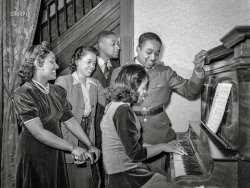
- Lemon, Center: 1921
- ... Post, Jan 7, 1920.
Lemon Helps Central Beat Baltimore Poly.
Jimmy Lemon, Central's left forward, by scoring seven ... from free passes, paved the way for Central to defeat the Baltimore Poly quintet at Baltimore yesterday, 24 to 22. The game was clean and ... Posted by Dave - 08/04/2012 - 3:49am -
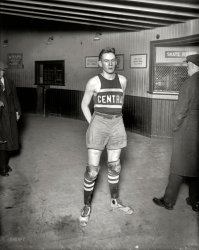
- Hanging Together: 1865
- ... later, my ancestor belonged to a fraternal organization in Baltimore. An applicant for membership to this group was asked if he had ...
I don't know if he was accepted or not, although Baltimore's Southern sympathies (her City Council spent the War in Fort McHenry ... Posted by Dave - 08/01/2012 - 4:03pm -
![Hanging Together: 1865 July 7, 1865. "Washington, D.C. Hanging hooded bodies of the four conspirators; crowd departing." Lincoln assassination conspirators Mary Surratt, Lewis Payne, David Herold and George Atzerodt shortly after their execution at Fort McNair. Wet plate glass negative by Alexander Gardner. View full size.
AdiosCapital punishment means never having to say, "You again"?
Lewis Payne's cause of deathI have read that Lewis Payne's neck muscles were so strong that the fall did not break his neck and he died of asphyxiation. Looking at the picture, it appears to be true. So sad. I've always suspected that they weren't all guilty, primarily Mary Surratt. Dr. Mudd almost ended up hanging, too.
Interesting timingIs Shorpy spying on me? I'm reading Assassination Vacation by Sarah Vowell right now, so I've been reading about these very conspirators. Weird.
Also, this looks like a miniature almost. Much like many pics in the faux tilt shift fad that the kids are so into these days. Which is odd because Vowell's book covers feature miniatures. Hmmm.
Nice work, Shorpy.
Last surviving witnessof the assassination of President Lincoln appeared on "I've Got a Secret" back in 1956.
Pot ShotThe two sergeants and the soldier in front of them have obviously turned around to see where the pot shot came from that shattered the glass just to their left.
Grim ReaperThat beardless seargent facing the camera looks like Death himself, hollow eyesockets and all, posing for posterity. It's not hard to imagine a sickle in place of the bayonet.
Spectator There are a lot of people moving in that photo. This one young boy is stock still.
Hanging AroundIf this were today they'd still be on death row waiting.
Their clothingBesides Mary Surratt, who would be wearing the dress (presumably, and yes, it does it make her look fat).
Lewis Payne appears to be wearing the same outfit seen here.
David Herold seems to be the one on the far right, he's dressed in dark pants like the ones in his picture here.
That leaves George Atzerodt, who doesn't seem to have a photo here on Shorpy.
They didn't mess around back then, you were executed quickly, no time to change into something nice I guess.
Christian "Wrath"The Army officer in charge of the gallows construction and giving the signal to the soldiers to knock out the supports under the traps was Captain Christian Rath of the Seventeenth Michigan Infantry. He can be seen in several of the photographs in this series.
More discussion on these images here on Facebook.
I interviewed Rath's great-niece who lived in his household. He was haunted by nightmares of Mrs. Surratt's daughter asking why he had hanged her mother.
There are several theories as to young soldier's identity.
Last Words"You can't hang me. I've got at least a dozen appeals left."
Ok this is weirdI too feel like Shorpy is spying on me. I was just tonight watching American Experience - The Assassination of Abraham Lincoln and I looked up Mary Surratt online to find out more about her story. I even read about the photographer who took this picture on Wikipedia. Strange.
[Love your jammies. - Dave]
Family connection, sort ofMy great-grandfather grew up in Bryanstown, Charles County, Maryland. One of his playmates was a son of Dr. Sam Mudd, a convicted co-conspirator who missed swinging with these people by one vote.
Many years later, my ancestor belonged to a fraternal organization in Baltimore. An applicant for membership to this group was asked if he had anything to add to what was already known about him. His reply was, "Yes. The United States of America murdered my mother, Mary Surratt."
I don't know if he was accepted or not, although Baltimore's Southern sympathies (her City Council spent the War in Fort McHenry without charges) were such that Mr. Surratt's views may have been a plus.
Mr. Surratt slipped out of Washington after the assassination. He was finally caught in Egypt many years later and brought back the the US for trial, where he was acquitted. By 1900 he had been a passenger agent for the Baltimore Steam Packet Company (Old Bay Line) for many years, which is about when my great-grandfather met him.
Game, Set, MatchYes, it is remarkable how fast they worked back in the day. My favorite example of speed in the not-so-distant past was the arrest, prosecution, conviction and execution of the fellow (Giuseppe Zangara) who tried to kill FDR in Miami. His shots were wide of the mark and he ended up mortally wounding Anton Cermak, who was standing next to President-Elect Roosevelt. The shooting happened February 15th 1933. He pled guilty almost immediately to four counts of attempted murder. Then Cermak dies after lingering in the hospital and Zangara is charged with murder. He pleads guilty to that charge too, and asks for the electric chair, and gets it after only 10 days of waiting on death row. March 20th, 1933 they light up Giuseppe in Old Sparky. 33 elapsed days. In by 9, out by 5!
In that orderThe order is as given in the caption: Surratt, Payne, Herold, Atzerodt.
An excellent, if creepy, book on the event was published in 2009: "The Lincoln Assassination Conspirators: Their Confinement and Execution."
Four noosesNo waiting!
Only WordGrim.
TimingI think Shorpy is spying on me as well. I just learned yesterday that woman hanging was a relative of F. Scott Fitzgerald.
Notice the two Sergeants?I can hear the one on the right saying, "Didja get the photo?"
Public ExecutionsThere are people today who want to make all executions public. They are anti death penalty supporters who feel that if the general public sees someone put to death, no matter how mundane the execution, it may lead to its ultimate goal of banning the death penalty. My feelings are that life without possibility of parole is a worse fate.
Oklahoma hanged four in 1909When I first moved to Oklahoma forty years ago, I was befriended by a very elderly and sweet lady who was born in Ada in 1895. She remembered a public hanging of four men there when she was 14. She told me nobody was barred from attending, the entire town turned out, they sold food, drinks and balloons and even children and babies were spectators. Ada was a Wild West town with rustlers, crooks and con men and "criminals needed killing" (not my words but hers). She remembered it as a carnival atmosphere and the attitude was that they got what they deserved. Quite a departure from human rights in our civilized times.
I read that Mary Suratt diedI read that Mary Suratt died very cleanly, as she fell into the trap door hole after she rose from a chair placed on the scaffold for her on the order of the executioner. Someone held an umbrella over her since the sun was so hot, until the moment when she rose from the chair.
Lewis, witnesses said, moved his legs into a sitting position twice after he was hanging from the rope, so his neck was not broken as he dropped . He got what he deserved, I think, having done brutal things to Secretary Seward while trying to kill him (Seward survived).
Suratt aided the assassins in many ways, giving them shelter and a place to meet in her house in Washington, and providing supplies at her farm in Maryland as they tried to escape after killing Lincoln. The law applied the most serious offense of the cabal - murder of the President - to all the conspirators. She was involved with the conspirators from the beginning, even if she was not integral to the plot.
Dr. Mudd was an innocent bystander, most likely, and so was spared the gallows, but he did spend time in prison, serving selflessly to save many during outbreaks of disease in the prison. He was released to return to Maryland where he was a respected member of the community until his death.
(The Gallery, Alexander Gardner, Civil War, D.C.)](https://www.shorpy.com/files/images/04230a.thumbnail.jpg)























